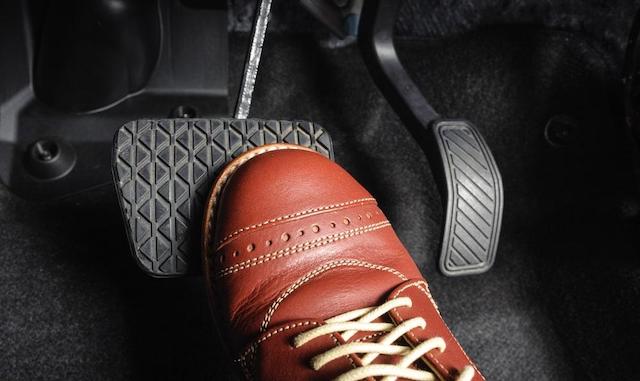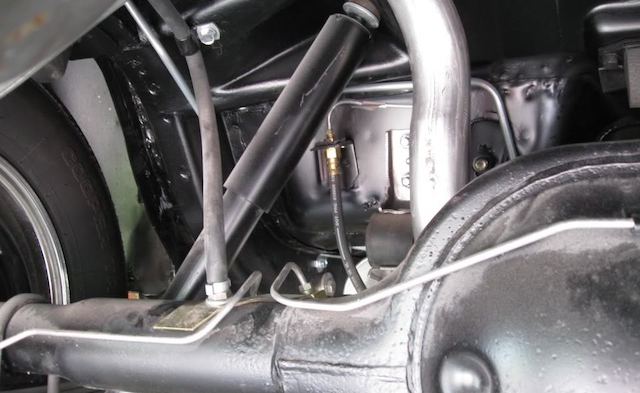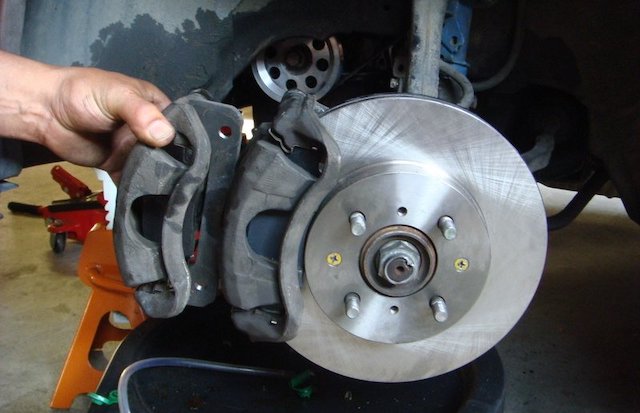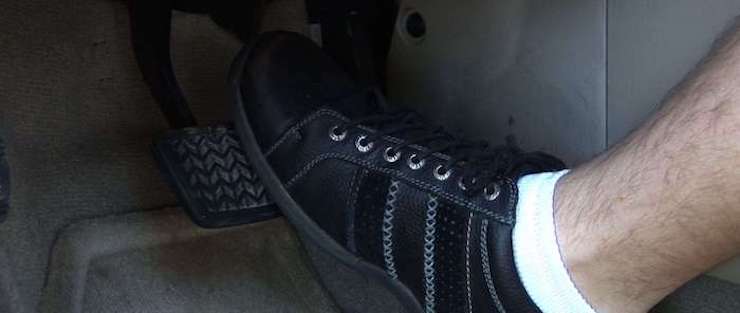Does it feel like your brake pedal is:
- Soft?
- Spongy?
- Dropping to the floor when braking?

If your answer to any of these is “yes”, there are a few braking components to pay attention to. Any one of these parts could be the source of the problem:
- Front or rear disk/drum assemblies
- Master cylinder
- Brake lines/ hoses
This diagnostic guide will walk you through the process of checking the components until you locate the problem.
Be Careful Not To Get Any Air Into The Brake Lines
Before you start digging into these components, bear in mind that auto brake systems are hydraulic systems. That means you should make an effort not to get any air into the brake lines when servicing the brakes. If the brakes were recently serviced, they may just need to be bled. Air in the brake lines will reduce the hydraulic system’s ability to stop the vehicle.
Step 1 – Inspect The Brake Fluid Reservoir and Master Cylinder

If your car is low on brake fluid, it will need more force on the brake pedal to stop. So the first thing you want to do is to check the brake fluid level. To do this:
- Open the hood and then find the reservoir for the brake fluid. It’s usually on the driver’s side of the engine bay, above the brake pedal and near the vacuum booster.
- Remove the reservoir cover. Check the brake fluid level. There should be two lines showing the acceptable minimum and maximum levels. If the brake fluid is under the minimum line, then your car is low on brake fluid.
Is the brake fluid level lower than it’s supposed to be? Chances are there’s a leak somewhere. Since you are already looking at the master cylinder, it’s easy to check it for any leaks. To do this:
- With a flashlight, check the lines connected to the master cylinder for accumulations of oily dirt.
- Look at the connection between the reservoir and the master cylinder for leaks.
- Check the reservoir for cracks.
If the master cylinder and brake fluid reservoir looks OK, move on to step 2.
Step 2 – Check The Lines/Hoses

The next thing to do is to get under the vehicle and look for signs of leakage. Brake fluid mostly evaporates and leaves behind an oily residue that attracts dirt. Check all the brake line connection points for oily dirt. If you find any, there could be an issue with the lines/hoses or fittings. If you find a leak, this post will show you how to replace the brake lines.
Step 3 – Inspect The Calipers (Or Wheel Cylinders)

Brake calipers can potentially leak from three places:
- The brake hose connection
- The bleed screw
- The piston
It’s easy to see the bleed screw and brake hose connection. Again, check for an oily residue. If either of these items are leaking, the fix is pretty easy. It’s harder to inspect the piston. Look at the inside of the bottom of the caliper to check for brake fluid. You may have to remove the caliper to thoroughly inspect the piston. If the piston is leaking, you are usually best off replacing the entire caliper.
If your vehicle has drum brakes, the wheel cylinder can leak. The first step is the look for brake fluid at the bottom of the brake backing plate. If you see any fluid there, you’ll need to remove the drum to confirm the leak.
I Can’t Find A Leak. What Else Could Be Wrong?
If you can’t find an obvious fluid leak, there are several other potential causes of a soft pedal. The next items you should inspect are:
Step 4 – Check The Master Cylinder Function

Your brake pedal is spongy because the master cylinder can’t maintain pressure. Sometimes it’s because other parts in the system have failed. Sometimes it’s the master cylinder itself. In this step, you’re going to see if the master cylinder has any underlying problems. After verifying that you have no fluid leaks, look for:
- Internal leakage: A seal inside the master cylinder may have failed, causing an internal leak. To confirm that your master cylinder has internal leakage, pump the brake pedal and then hold it down. Did the pedal start to creep downward? If so, it’s likely that the master cylinder is leaking internally because it can’t keep pressure. The best solution is to replace the entire master cylinder.
Step 5 – Check The Disc Or Drum Brake Assembly

It’s possible that your brake pads and/or rotors may have worn too thin. When that happens, you have to apply more pressure to the brakes to stop the vehicle. Sometimes you have to press the brake pedal to the floor. To check the disc or drum brake assembly:
- Lift your vehicle.
- Remove the wheels.
- Check the rotors, brake pads, and/or drum assemblies.
- Give everything a visual inspection.
- If you’re not sure if a rotor or pad has worn too thin, measure it.
Were you able to find the cause of your soft brake pedal? If not, give us a call. We’d be happy to give you more guidance.



